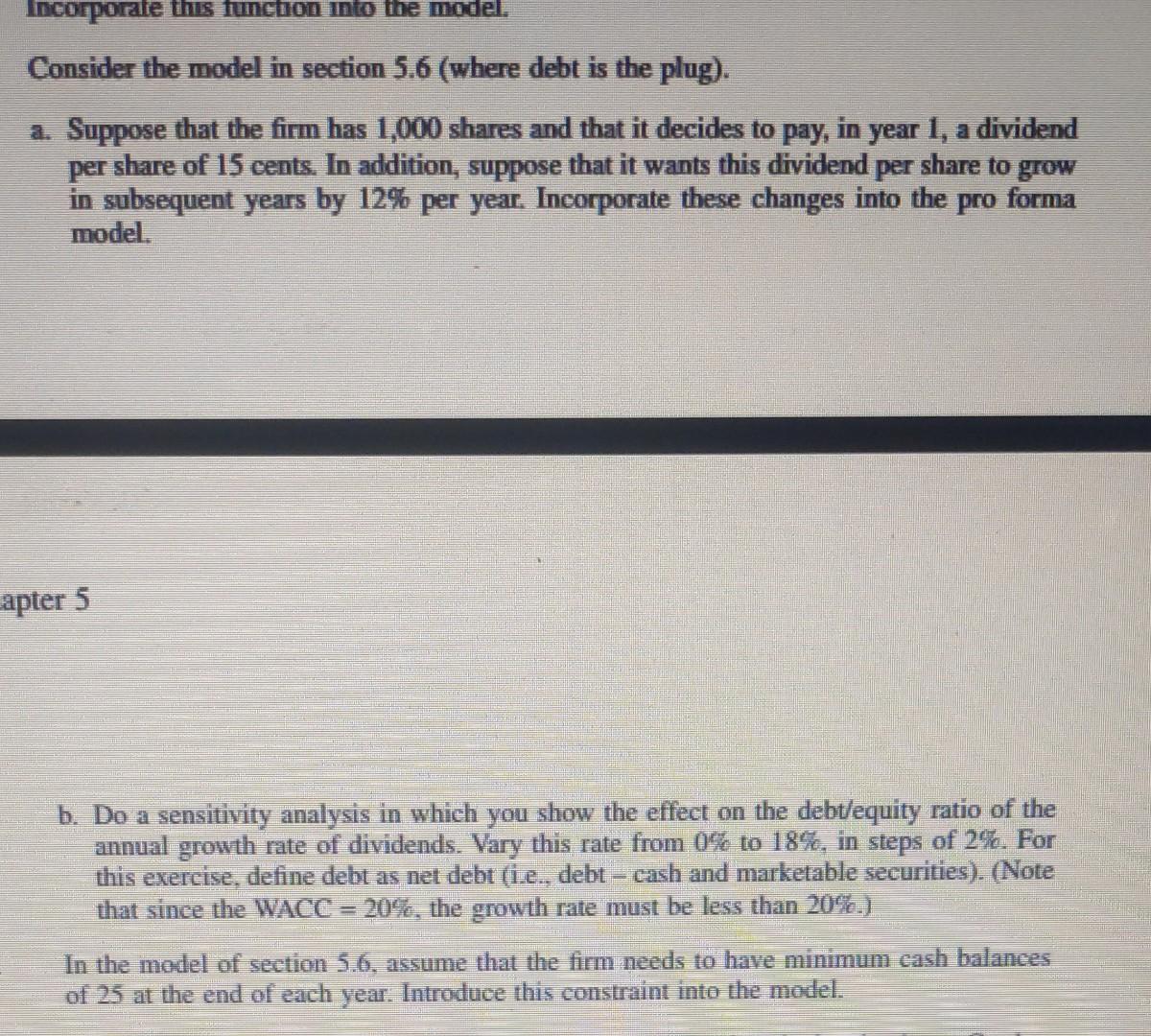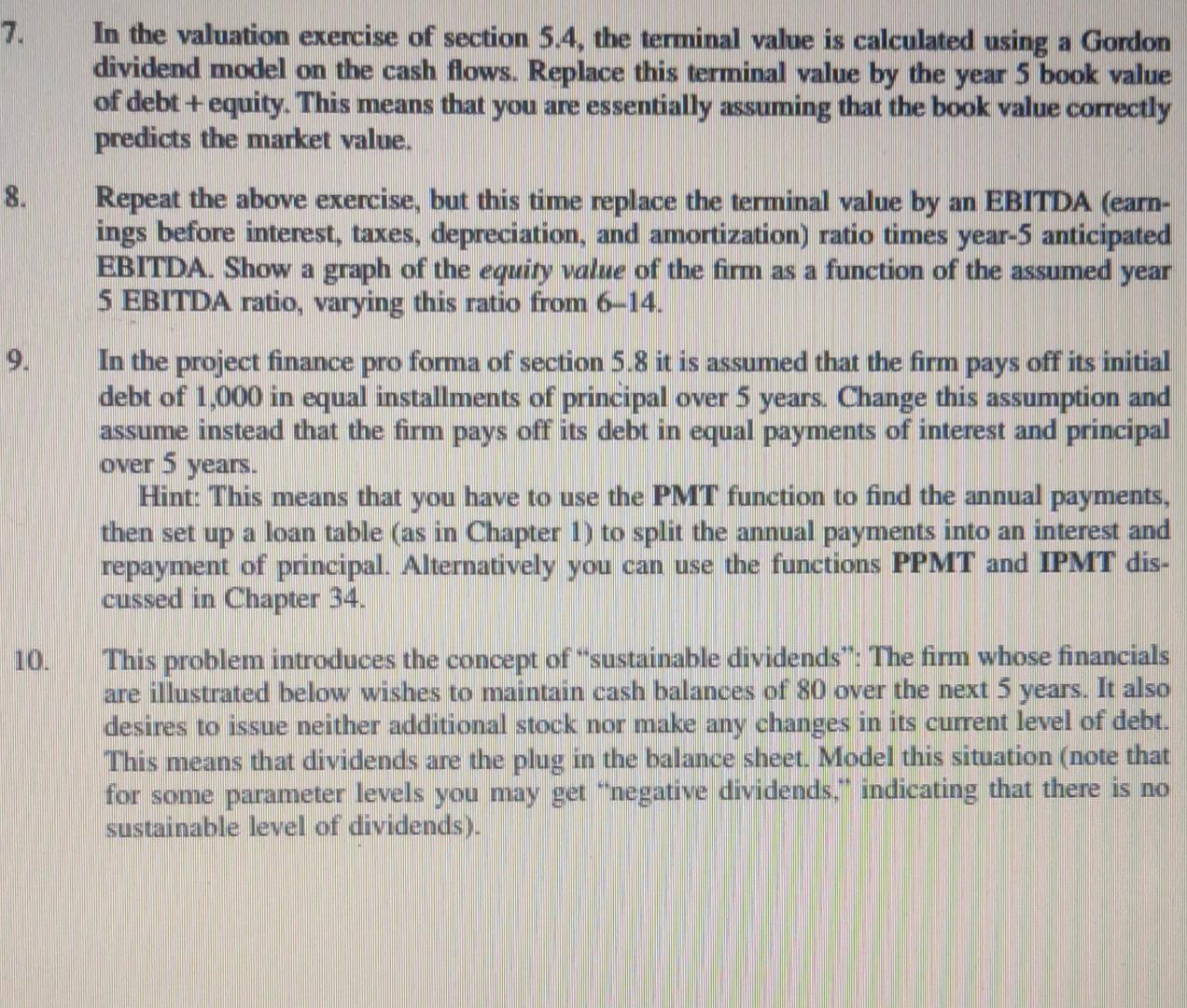Answered step by step
Verified Expert Solution
Question
1 Approved Answer
Incorporate this function into the model. Consider the model in section 5.6 (where debt is the plug). a. Suppose that the firm has 1,000 shares


Incorporate this function into the model. Consider the model in section 5.6 (where debt is the plug). a. Suppose that the firm has 1,000 shares and that it decides to pay, in year 1, a dividend per share of 15 cents. In addition, suppose that it wants this dividend per share to grow in subsequent years by 12% per year. Incorporate these changes into the pro forma model. apter 5 b. Do a sensitivity analysis in which you show the effect on the debt/equity ratio of the annual growth rate of dividends. Vary this rate from 0% to 18%, in steps of 2%. For this exercise, define debt as net debt (i.e., debt - cash and marketable securities). (Note that since the WACC = 20%, the growth rate must be less than 20%.) In the model of section 5.6, assume that the firm needs to have minimum cash balances of 25 at the end of each year. Introduce this constraint into the model. 7. In the valuation exercise of section 5.4, the terminal value is calculated using a Gordon dividend model on the cash flows. Replace this terminal value by the year 5 book value of debt+equity. This means that you are essentially assuming that the book value correctly predicts the market value. 8. Repeat the above exercise, but this time replace the terminal value by an EBITDA (eam- ings before interest, taxes, depreciation, and amortization) ratio times year-5 anticipated EBITDA. Show a graph of the equin value of the firm as a function of the assumed year 5 EBITDA ratio, varying this ratio from 6-14. 9. In the project finance pro forma of section 5.8 it is assumed that the firm pays off its initial debt of 1,000 in equal installments of principal over 5 years. Change this assumption and assume instead that the firm pays off its debt in equal payments of interest and principal over 5 years. Hint: This means that you have to use the PMT function to find the annual payments, then set up a loan table (as in Chapter 1) to split the annual payments into an interest and repayment of principal. Alternatively you can use the functions PPMT and IPMT dis- cussed in Chapter 34. 10. This problem introduces the concept of "sustainable dividends": The fim whose financials are illustrated below wishes to maintain cash balances of 80 over the next 5 years. It also desires to issue neither additional stock nor make any changes in its current level of debt. This means that dividends are the plug in the balance sheet. Model this situation (note that for some parameter levels you may get "negative dividends." indicating that there is no sustainable level of dividends). Incorporate this function into the model. Consider the model in section 5.6 (where debt is the plug). a. Suppose that the firm has 1,000 shares and that it decides to pay, in year 1, a dividend per share of 15 cents. In addition, suppose that it wants this dividend per share to grow in subsequent years by 12% per year. Incorporate these changes into the pro forma model. apter 5 b. Do a sensitivity analysis in which you show the effect on the debt/equity ratio of the annual growth rate of dividends. Vary this rate from 0% to 18%, in steps of 2%. For this exercise, define debt as net debt (i.e., debt - cash and marketable securities). (Note that since the WACC = 20%, the growth rate must be less than 20%.) In the model of section 5.6, assume that the firm needs to have minimum cash balances of 25 at the end of each year. Introduce this constraint into the model. 7. In the valuation exercise of section 5.4, the terminal value is calculated using a Gordon dividend model on the cash flows. Replace this terminal value by the year 5 book value of debt+equity. This means that you are essentially assuming that the book value correctly predicts the market value. 8. Repeat the above exercise, but this time replace the terminal value by an EBITDA (eam- ings before interest, taxes, depreciation, and amortization) ratio times year-5 anticipated EBITDA. Show a graph of the equin value of the firm as a function of the assumed year 5 EBITDA ratio, varying this ratio from 6-14. 9. In the project finance pro forma of section 5.8 it is assumed that the firm pays off its initial debt of 1,000 in equal installments of principal over 5 years. Change this assumption and assume instead that the firm pays off its debt in equal payments of interest and principal over 5 years. Hint: This means that you have to use the PMT function to find the annual payments, then set up a loan table (as in Chapter 1) to split the annual payments into an interest and repayment of principal. Alternatively you can use the functions PPMT and IPMT dis- cussed in Chapter 34. 10. This problem introduces the concept of "sustainable dividends": The fim whose financials are illustrated below wishes to maintain cash balances of 80 over the next 5 years. It also desires to issue neither additional stock nor make any changes in its current level of debt. This means that dividends are the plug in the balance sheet. Model this situation (note that for some parameter levels you may get "negative dividends." indicating that there is no sustainable level of dividends)
Step by Step Solution
There are 3 Steps involved in it
Step: 1

Get Instant Access to Expert-Tailored Solutions
See step-by-step solutions with expert insights and AI powered tools for academic success
Step: 2

Step: 3

Ace Your Homework with AI
Get the answers you need in no time with our AI-driven, step-by-step assistance
Get Started


